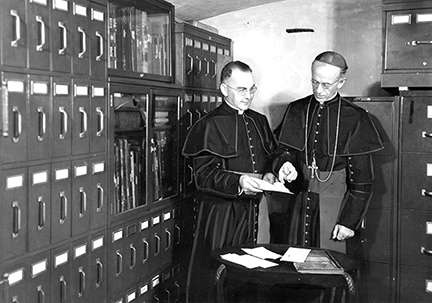From the Archives
By Mary Woodward
This week we are taking a short break from Bishop Janssens (fourth bishop) to honor our seventh bishop, Richard Oliver Gerow on the 100th anniversary of his consecration and coming to our diocese. Since this is an article series from the archives, and Bishop Gerow organized our diocesan archive, it would be sacrilege if I let this anniversary pass by without due recognition.
Bishop Gerow was consecrated on Oct. 15, 1924, in the Cathedral Basilica of the Immaculate Conception in Mobile. He grew up in the shadows of the cathedral and was baptized and confirmed there. Bishop Edward Allen of Mobile was the principal consecrator and the bishop whom Rev. Gerow has served under for several years.
After the grand liturgy, the young bishop spent a few weeks tying up some loose ends in his hometown, then headed for his new diocese on Nov. 11, by way of New Orleans. Following a visit with Archbishop John Shaw, Gerow, the Archbishop, and the delegation from Mobile boarded a special midnight train to his new diocese.

The Illinois Central Sleeper arrived in Brookhaven a little before 5 a.m. on Wednesday, Nov. 12. The new bishop was met by a delegation from St. Francis, the local parish, where he celebrated his first Mass in the diocese. A transfer train from Natchez arrived at 8 a.m. in Brookhaven carrying a large delegation from the See City. Bishop Gerow and his entourage boarded the train and arrived in Natchez at 10 a.m. to a warm welcome from the town.
So that he might travel around the entire diocese and see all its parishes and clergy, Bishop Gerow appointed Msgr. Prendergast as vicar general and entrusted most of the details of church business to him until Christmas. All of this is documented in the first few pages of Bishop Gerow’s monumental diary described below.
To be honest we have one of the most complete archives of Mississippi history in the state, albeit a history through the unique lens of the development of the Catholic Church in the region. The collection is a national treasure. Bishop Gerow is the reason for this.
As a meticulous historian who knew the importance of maintaining proper records and information, Bishop Gerow, assisted by various chancellors along the way, built the comprehensive collection we have in the vault over a period of 42 years.
He kept a detailed diary, as did several of his predecessors, of the daily events in the life of the church as he lived them. His diary is several thousand pages typed up neatly and bound in volumes. His last entry details his retirement in 1966.
He also oversaw the indexing of the six previous bishops’ papers and correspondence along with all the official acts of the office of bishop and the diocesan church.
An avid photographer, he photographed churches and diocesan structures while he travelled throughout the entire state. A small fraction of these is part of our collection in the Mississippi Digital Library. Visit the collection at https://msdiglib.org/cdj.
Bishop Gerow moved the bishop’s residence and office to Jackson from Natchez and brought most of the archive collection with him. The archives’ vault was built into the ground floor of the diocesan chancery building during its construction in 1947. Our archive collection has documents dating back to the late 1700s with some books dating back farther than that.
Today, the vault is stacked to the ceiling and diocesan records since 1966 are slowly being indexed for future research. There is a great need for space and the vision is to one day have a building for the diocesan archives that can serve as a research center and small museum for educational purposes.
Recently, we have had to close the collection to any research due to a moisture issue that caused some archive collection-specific mold; plus, some of our microfilm rolls of older sacramental records have contracted the dreaded vinegar disease and have been isolated to keep it from spreading to other rolls.
Right now, we manage our treasure the best we can within the allotted space. And we hope one day to be able to better share that treasure in a more appropriate environment.
Until then, I hope you will continue to appreciate the history we share in the space provided in this column.
(Mary Woodward is Chancellor and Archivist for the Diocese of Jackson.)
